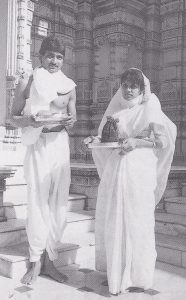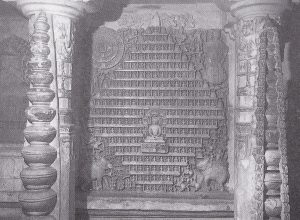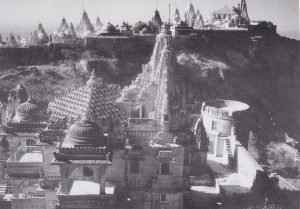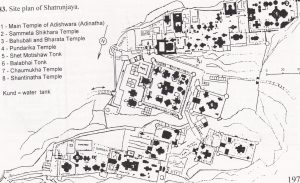Mount Shatrunjaya
O lord of peaks Shatrunjaya! How can en wise people describe in brief your qualities Due to the influence of this tirtha, there is causpicious mental modifica tion of men who come on pilgrimage 4 pious man eliminates sin by placing on his limbs dust from the carts and the four of the horses, camels and men in a congre gation who go on pilgrimage to you, (YO you whose glory is praised by Indra You should be praised. O land of perfection with mind, speech and body.
From a fourteenth century Guidebook to various Pilgrimage Places by Muni linaprabhasur Translated by John E Cont.
Lamenting over misfortunes, be they of personal or of general nature, is not to the liking of believers in Jainism. Laments like those of Job or Jeremiah in the Jewish Bible are not found in the Jaina canon.
After the temples on the summit of Shatrun- jaya were sacked by Turkish Muslims in 1311 – Muni Jinaprabhasuri, the author of the above quotation, was then in his fiftieth year- the first reaction by leading Jainas was not the thought of revenge but of how to repair the damage and to replace the desecrated images.
True to this determination, rebuilding began within two years. but most of what one sees on Shatrunjaya today is of a much later date.
From the outside the ‘new’ Shatrunjaya the hill which conquers enemies looks like a fortress yet apparently there never was a garrison to defend it. (With “enemies’ our vices are meant that cause bad karma.)
Climbing the 3750 steps on a bright early morning during the winter months of November to March is in itself already an experience that remains in one’s memory. Articles of leather or fur must be left behind or deposited at the appropriate places near the entrance. Owners of cameras should inquire whether a written permit to photograph is still required, and if so where it may be obtained (see appendix).
For the Shvetambara Jainas Shatrunjaya is the earliest and, next to Sammeta Shikhara in Bihar. the most sacred mountain. Traditionally it was Adinatha or Rishabhanatha, the first Tirthankara of our age, who is said to have sanctified the hill
 Shatrunjaya Pilgrims are expected to bath and don clean garments before paying homage to the image of Adinatha in the holy of holies. Here it is a newly married couple.
Shatrunjaya Pilgrims are expected to bath and don clean garments before paying homage to the image of Adinatha in the holy of holies. Here it is a newly married couple.
In The Clever Adulteress edited by Phyllis Granhoff Delhi, 1993 251)
by visiting it to deliver his first sermon. However, it was not Rishabha sonetimes stated, who died and attained salvation on Shatrunjaya but his grandnno Pundarika, thus Shatrunjaya is also called Pundarikagiri.
Bharata, the father of Pundarika and half-brother of Bahubali, is likewise credited with having frequented Shatrunjaya and established a tirtha about nine kilometres south of Palitana. There, on a hill near the river, a new complex of five temples is nearing completion bearing the name Hastagiri, meaning ‘elephant hill’. Tradition has it that at this spot Bharata and his elephant obtained release from samsara, the cycle of perpetual rebirth.
Palitana is the name of the township which has, in close proximity, both a bus and a railway station. From here horse-drawn tongas take the visitor through the town and then along a straight road to the Jay Taleti Mandir at the foot of Shatrunjaya. The last mile of this long road is lined with dharmashalas, temples, a museum and houses for monks and nuns respectively. In 1656 the Mughal governor of Gujarat, a Muslim, gave custody of Palitana to the Jaina merchant Shantidas Jhaveri.
For pilgrims swift of foot there are three circumambulatory routes. The shortest leads round the temples along the outer wall: the other follows the foot of the moun- tain. The third, about forty kilometres long. frequents en route five temple sites where pilgrims may stay overnight before continuing their holy walk. The major event of the year takes place on the day of the full moon in the month of Phalgun (Fch /March) when some ten thousands of pilgrims circumambulate Shatrunjaya hill, the Lord of Peaks’.
on the day of the full moon in the month of Phalgun (Fch /March) when some ten thousands of pilgrims circumambulate Shatrunjaya hill, the Lord of Peaks’.
Shatrunjaya. Large panel showing a seated Tirthankara surrounded by a multitude of smaller Jinas It symbolizes a holy mountain. At the top left a sumavasarana on the opposite side a diagram depicting the Jaina cosmos in form of a human figure (loka-purusha).
 Part view of Shatrunjaya. Top right the Adishwara Temple, the main shrine of the 180 large temples and 872 small shrines.’ These two figures, as any others found in publications, should not be taken at face value. There are no standard criteria for describing a temple as big or small.
Part view of Shatrunjaya. Top right the Adishwara Temple, the main shrine of the 180 large temples and 872 small shrines.’ These two figures, as any others found in publications, should not be taken at face value. There are no standard criteria for describing a temple as big or small.

Site plan of Shatrunjaya.
